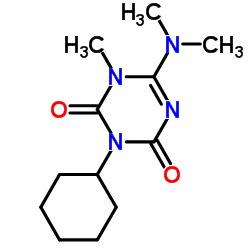Hexazinone

Hexazinone structure
|
Common Name | Hexazinone | ||
|---|---|---|---|---|
| CAS Number | 51235-04-2 | Molecular Weight | 252.313 | |
| Density | 1.3±0.1 g/cm3 | Boiling Point | 332.8±25.0 °C at 760 mmHg | |
| Molecular Formula | C12H20N4O2 | Melting Point | 97-100.5ºC | |
| MSDS | Chinese USA | Flash Point | 155.1±23.2 °C | |
| Symbol |



GHS02, GHS06, GHS08 |
Signal Word | Danger | |
|
The interaction between natural organic matter in raw waters and pesticide residues: a three dimensional excitation-emission matrix (3DEEM) fluorescence investigation.
Water Sci. Technol. 67(11) , 2428-36, (2013) This paper examines the interaction between dissolved natural organic matter and pesticide residues, both of which are found in raw water sources, using three dimensional excitation-emission matrix (3DEEM) fluorescence spectroscopy. It was observed that pesti... |
|
|
Dissipation of four forest-use herbicides at high latitudes.
Environ. Sci. Pollut. Res. Int. 15(7) , 573-83, (2008) Large-scale deforestation is occurring in subarctic North America following clearing by salvage logging or insect attack. Numerous shrubs, herbs, and deciduous tree species tend to dominate areas on which stands of white spruce have grown. In the absence of e... |
|
|
Comparison between the short-term and the long-term toxicity of six triazine herbicides on photobacteria Q67
Water Res. 43(6) , 1731-9, (2009) The bioluminescence inhibition of six triazine herbicides including desmetryne (DES), simetryn (SIM), velpar (VEL), prometon (PRO), metribuzin (MET), and aminotriazine (AMI) on Vibrio qinghaiensis sp.-Q67 (Q67) was determined to investigate the effects of exp... |
|
|
Combined photobacterium toxicity of herbicide mixtures containing one insecticide.
Chemosphere 75(3) , 381-8, (2009) To test whether the dose-addition (DA) model can predict the combined toxicity of the mixtures of herbicides that coexisted with insecticide(s), we selected five herbicides (simetryn, prometon, bromacil, velpar, and diquat) and one organophosphorus insecticid... |
|
|
Impacts of stage-specific acute pesticide exposure on predicted population structure of the soft-shell clam, Mya arenaria.
Aquat. Toxicol. 98(3) , 265-74, (2010) A combined laboratory and modeling approach was used to assess the impact of selected pesticides on early life stages of the soft-shell clam, Mya arenaria. Clams were exposed for 24h as veligers or pediveligers to the broad-spectrum herbicide hexazinone [3-cy... |
|
|
Modelling the dissipation kinetics of six commonly used pesticides in two contrasting soils of New Zealand.
J. Environ. Sci. Health B 44(6) , 507-17, (2009) We used three non-linear bi-phasic models, bi-exponential (BEXP), first-order double exponential decay (FODED), and first-order two-compartment (FOTC), to fit the measured degradation data for six commonly used pesticides (atrazine, terbuthylazine, bromacil, ... |
|
|
Anaerobic biodegradation of hexazinone in four sediments.
J. Hazard. Mater. 164(2-3) , 806-11, (2009) Anaerobic biodegradation of hexazinone was investigated in four sediments (L1, L2, Y1 and Y2). Results showed that the L2 sediment had the highest biodegradation potential among four sediments. However, the Y1 and Y2 sediments had no capacity to biodegrade he... |
|
|
Degradation and metabolism of hexazinone by two isolated bacterial strains from soil.
Chemosphere 61(10) , 1468-74, (2005) Two hexazinone-degrading bacterial strains were isolated from soil by enrichment culture technique, and identified as Pseudomonas sp. and Enterobacter cloacap. The two purified isolates, designated as WFX-1 and WFX-2, could rapidly degrade hexazinone with a h... |
|
|
Photocatalytic degradation of hexazinone and its determination in water via UPLC–MS/MS
J. Hazard. Mater. 221-222 , 100-8, (2012) Highlights ► Photocatalysis of nano-TiO2 is applied for degradation of hexazinone in water. ► Influences of various parameters for the photocatalytic degradation are studied. ► Small photocatalytic degradation by-products are identified ► Total and nontoxic d... |
|
|
Movement of diuron and hexazinone in clay soil and infiltrated pond water.
J. Environ. Qual. 34(6) , 2005-17, (2005) Pre-emergence herbicide residues were detected in domestic wells sampled near Tracy, CA. This study sought to determine the source of contamination by comparing soil distribution of diuron [N'-(3,4-dichlorophenyl)-N,N-dimethylurea] and hexazinone [3-cyclohexy... |